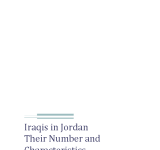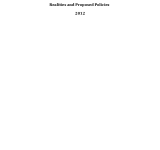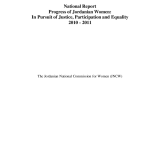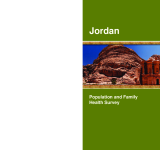This report consists of eight chapters and aims to summarise the key concepts of human development. It introduces the Human Development Index;; provides an overview of Jordan's human development achievements;; examines the regional vulnerability context that has constrained Jordan's options in its pursuit of social and economic development;; provides a platform for the poor to express their views and perceptions in relation to their poverty status;; reviews the policies;; institutions and processes that affect the poor;; examines the government's attempts to stimulate entrepreneurialism;; promotes the application of a rights-based approach;; in which all citizen are equally empowered and have the capacity and the appropriate enabling environment that allows them to claim their entitlements according to law. Finally;; the study examines the various reform initiatives in progress and assesses the extent to which Jordan is committed to the process.
ownership
This report summarises the number of Iraqis residing in Jordan since 2007 and highlights their characteristics.
This report was jointly prepared by the Jordanian National Commission for Women (JOHUD);; the Jordan Hashemite Fund for Human development/Regional Economic Empowerment of Women Project (REEWP) and the United Nations Population Fund (UNFPA). The report discusses the right to inheritance and debates a number of issues including the provisions concerning women's rights to inheritance in Islam;; the legal framework of the women's rights to inheritance in Jordan;; the guarantees of these rights and finally the reality of the women's right to inheritance in Jordan. The report concludes with recommendations.
This national report is designed to trace the progress of women in various fields;; monitoring achievements;; and highlighting gaps and failures;; as well as analyzing indicators;; recommending measures;; and measuring levels of achievements in the implementation of plans and strategies. The main themes were selected according to national priorities dictated by each stage: Legal Protection for Women's Right to Access Justice;; Participation;; the Economic Empowerment of Jordanian Women;; Equality;; Citizenship and Decision-Making in Public Life. The conclusions of this report confirm that a much smaller effort was exerted at the level of providing information;; data and the provision of services in the area of providing justice and facilitating ways of achieving it. The lack of knowledge about available services among women;; whether provided by civil society organizations or government institutions;; affects women's ability to access justice negatively. Regarding the economic participation the Policies and plans that targeted empowering women economically show that the result of these policies was weak and limited. Difficulty of women’s access to job opportunities in the private sector and inequitable pay between the sexes;; lack of supporting services to working women;; including childcare Facilities;; poor matching between education outputs and skills required in the labor market and the traditional social standards that contribute to directing females towards certain professions. The report proposed general recommendations and directions that include quick solutions to deal with the main highlighted challenges.
هدفت الدراسة الى التعرف على الخصائص الديموغرافية والظروف الاقتصادية والاجتماعية للأسر التي ترأسها امرأة وتحديد طبيعة المشكلات التي تواجهها وابناؤها وبالتالي تحديد اوجه واولويات التدخل وطبيعة المساعدات التي يمكن تقديمها لهذه الأسر. اعتمدت الدراسة المنهج الكمي والنوعي;; حيث استخدمت التحليلات الاحصائية SPSS;; واجراء المقابلات الفردية ومجموعات نقاش مركزة. عينة الدراسة كانت 1200 اسرة على مستوى الاقاليم الثلاث (شمال;; وسط;; جنوب) وكانت العينة عشوائية. وكما تم بناء استبيان لجمع البيانات. ولقد خرجت الدراسة بمجموعة من النتائج. وكما قدمت الدراسة مجموعة من التوصيات لمساعدة هذه الأسر في التغلب على النظرة النمطية والضغوط الاقتصادية.
يتضمن هذا التقرير تحليلاً موسعاً ومتكاملاً لمؤشرات الفقر بالاستناد الى بيانات مسح نفقات ودخل الأسرة لعام 2008;; الذي نفذته دائرة الاحصاءات العامة على أربع جولات ميدانية استمرت سنة;; والذي انتهى العمل به مع نهاية الربع الأول لعام 2009. وبناءاً على بيانات هذا المسح تم اعداد تقريرين سابقين: الأول كان فيه عرض للنتائج الرئيسية للمسح والآخر تناول قياس مؤشرات الفقر باستخدام منهجية السعرات الحرارية المعتمدة من قبل البنك الدولي ومقارنتها عبر الزمن بالأسعار الثابتة. وبناءاً عليه تم تم اعداد هذا التقرير التحليلي لحالة الفقر في الأردن;; وذلك بمشاركة العديد من الجهات الوطنية المعنية بالفقر. وكما يتناول التقرير تحليلاً للتدخلات الحكومية المباشرة بالأسعار الجارية خلال عام 2008 في الحد من ظاهرة الفقر.
يلخض هذا التقرير نتائج مسح السكان والصحة الأسرية في الأردن 2009 الذي أجرته دائرة الاحصاءات العامة. ونفذ هذا المسح ضمن برنامج المسوح الديموغرافية والصحية الذي صمم لجمع بيانات عن الانجاب وتنظيم الأسرة وصحة الأمهات ووفيات الأطفال والرضع والحالة التغذوية بين النساء والأطفال. تم مقابة عينة ممثلة من الأسر على مستوى المملكة بلغت 13577 أسرة;; وكذلك 10109 سيدة سبق لهن الزواج ضمن الفئة العمرية 15-49 سنة;; وتوفر هذه العينة تقديرات على مستوى المملكة ككل وعلى مستوى الحضر والريف ومناطق البادية والأقاليم الثلاثة;; وعلى مستوى المحافظات.






